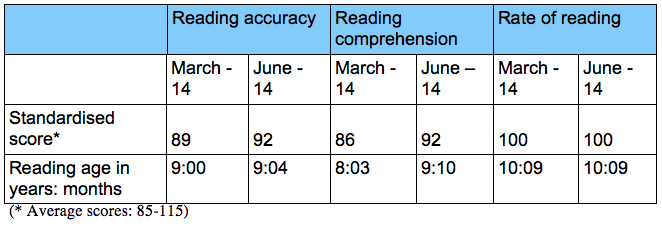Case studies
Primary 4: A small school in a rural village
Fact file
| Location | South East |
| Setting | Rural |
| Size | One form entry |
| Proportion of SEN | Highest quintile |
| Pupils eligible FSM | Highest quintile |
| KS2 reading results performance band (similar schools, 2013) | Second quintile |
| KS2 reading results performance band (national, 2013) | Fourth quintile |
Background
The Rhythm for Reading intervention programme had been recommended by another school.
Delivery
The programme ran for a ten-week period from the middle of March to June 2014 with sixty Year 5 and Year 6 students taught in groups of ten. Each group took part in one ten-minute session each week for ten weeks.
Assessment
To measure the impact of the Rhythm for Reading intervention programme, twelve of the Year 5 and 6 students were selected by the head teacher and her team for individual reading assessment. The twelve were either FSM or EAL students and were measured on oral reading using NARA before and after the ten-week Rhythm for Reading programme. Nine pupils attended school on both testing dates.
Progress report
The average (mean) reading scores for the group showed gains in reading accuracy (4 months) and reading comprehension (19 months) following the ten-week intervention programme. The standardised scores for the Year 5/6 FSM & EAL students indicate that the rate of progress was faster than might have been expected.

FSM or EAL Year 5/6 student voices
‘Monica’ (FSM)
Before the programme began, Monica could read quickly, but her reading accuracy her reading comprehension ages were 15 and 24 months behind her chronological age respectively.
I can read much better now.
Monica was attentive and quiet during the sessions. In the follow-up tests, a small change had occurred in her reading accuracy (1 month), but there was a very considerable change in her reading comprehension age (37 months).
‘Florian’ (EAL)
Florian’s accuracy and comprehension age scores were 34 months and 47 months lower than expected for his age.
I learn more stuff.
Florian participated conscientiously during the Rhythm for Reading sessions. A strong gain occurred in his reading comprehension (18 months), and in his reading accuracy (9 months). At the end of the ten weeks, all of Florian’s standardised reading scores were within the average range for his age.
The students’ names have been changed to protect their identity.
